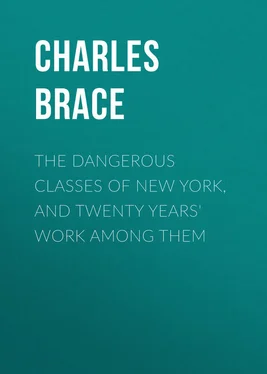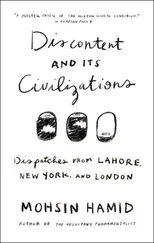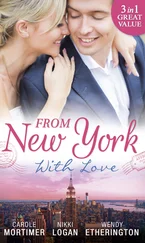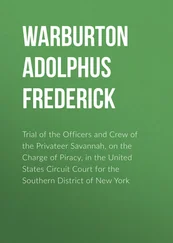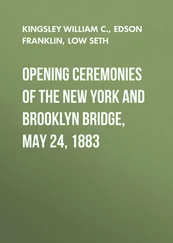Charles Brace - The Dangerous Classes of New York, and Twenty Years' Work Among Them
Здесь есть возможность читать онлайн «Charles Brace - The Dangerous Classes of New York, and Twenty Years' Work Among Them» — ознакомительный отрывок электронной книги совершенно бесплатно, а после прочтения отрывка купить полную версию. В некоторых случаях можно слушать аудио, скачать через торрент в формате fb2 и присутствует краткое содержание. Издательство: Иностранный паблик, Жанр: foreign_antique, foreign_prose, на английском языке. Описание произведения, (предисловие) а так же отзывы посетителей доступны на портале библиотеки ЛибКат.
- Название:The Dangerous Classes of New York, and Twenty Years' Work Among Them
- Автор:
- Издательство:Иностранный паблик
- Жанр:
- Год:неизвестен
- ISBN:нет данных
- Рейтинг книги:5 / 5. Голосов: 1
-
Избранное:Добавить в избранное
- Отзывы:
-
Ваша оценка:
- 100
- 1
- 2
- 3
- 4
- 5
The Dangerous Classes of New York, and Twenty Years' Work Among Them: краткое содержание, описание и аннотация
Предлагаем к чтению аннотацию, описание, краткое содержание или предисловие (зависит от того, что написал сам автор книги «The Dangerous Classes of New York, and Twenty Years' Work Among Them»). Если вы не нашли необходимую информацию о книге — напишите в комментариях, мы постараемся отыскать её.
The Dangerous Classes of New York, and Twenty Years' Work Among Them — читать онлайн ознакомительный отрывок
Ниже представлен текст книги, разбитый по страницам. Система сохранения места последней прочитанной страницы, позволяет с удобством читать онлайн бесплатно книгу «The Dangerous Classes of New York, and Twenty Years' Work Among Them», без необходимости каждый раз заново искать на чём Вы остановились. Поставьте закладку, и сможете в любой момент перейти на страницу, на которой закончили чтение.
Интервал:
Закладка:
We have spoken of the greater tendency of large cities, as compared with villages, in breaking up vicious families. There is another advantage of cities in this matter. The especial virtue of a village community is the self-respect and personal independence of its members. No benefits of charity or benevolent assistance and dependence could ever outweigh this. But this very virtue tends to keep a wicked or idle family in its present condition. The neighbors are not in the habit of interfering with it; no one advises or warns it. The children grow up as other people's children do, in the way the parents prefer; there is no machinery of charity to lift them out of the slime; and if any of their wealthier neighbors, from motives of benevolence, visited the house, and attempted to improve or educate the family, the effort would be resented or misconstrued. The whole family become a kind of pariahs ; they are morally tabooed, and grow up in a vicious atmosphere of their own, and really come out much worse than a similar family in the city. This phenomenon is only a natural effect of the best virtues of the rural community.
In a large town, on the other hand, there exist machinery and organization through which benevolent and religious persons can approach such families, and their good intentions not be suspected or resented. The poor people themselves are not so independent, and accept advice or warning more readily; they are not so stamped in public repute with a bad name; less is known of them, and the children, under new influences, break off from the vicious career of their parents, and grow up as honest and industrious persons. Moreover, the existence of so much charitable organization in the cities brings the best talent and character of the fortunate classes to bear directly on the unfortunate, far more than is the fact in villages.
CHAPTER V
The source of juvenile crime and misery in New York, which is the most formidable, and, at the same time, one of the most difficult to remove, is the overcrowding of our population. The form of the city-site is such – the majority of the dwellings being crowded into a narrow island between two water-fronts – that space near the business-portion of the city becomes of great value. These districts are necessarily sought for by the laboring and mechanic classes, as they are near the places of employment. They are avoided by the wealthy on account of the population which has already occupied so much of them. The result is, that the poor must live in certain wards; and as space is costly, the landlords supply them with (comparatively) cheap dwellings, by building very high and large houses, in which great numbers of people rent only rooms, instead of dwellings.
Were New York a city radiating from a centre over an almost unlimited space – as Philadelphia, for instance – the laborers or the mechanics might take up their abode anywhere, and land would be comparatively cheap, so that the highest blessing of the laboring class would be attainable – of separate homes for each family. But, on this narrow island, business is so peculiarly concentrated, and population is so much forced to one exit – towards the north – and the poor have such a singular objection to living beyond a ferry, that space will inevitably continue very dear in New York, and the laboring classes will be compelled to occupy it.
To add to the unavoidable costliness of ground-room on this island, has come in the effect of bad government.
It is one of the most unpleasant experiences of the student of political economy, that the axioms of his science can so seldom be understood by the masses, though their interests be vitally affected by them. Thus, every thoughtful man knows that each new "job" among city officials, each act of plunder of public property by members of the municipal government, every loss of income or mal-appropriation or extravagance in the city's funds, must be paid for by taxation, and that taxation always falls heaviest on labor. The laboring classes of the city rule it, and through their especial leaders are the great public losses and wastefulness occasioned.
Yet they never know that they themselves continually pay for these in increased rents. Every landlord charges his advanced taxation in rent, and probably a profit on that. The tenant pays more for his room, the grocer more for his shop, the butcher and tailor and shoemaker, and every retailer have heavier expenses from the advance in rents, and each and all charge it on their customers. The poor feel the final pressure. The painful effect has been, that the expense for rent has arisen enormously with the laboring classes of this city during the last five years, while many of the other living expenses have nearly returned to the standard before the war.
The influence of high rents is to force more people into a given space, in order to economize and divide expense.
The latest trustworthy statistics on this important subject are from the excellent Reports of the Metropolitan Board of Health for 1866. From these, it appears that the Eleventh Ward of this city, with a population of 58,953, has a rate of population of 196,510 to the square mile, or 16 1/10 square yards to each person; the Tenth Ward, with 31,587 population, has a rate of 185,512 to the square mile, or 17 1/10 square yards to each; the Seventeenth Ward, with 79,563, has the rate of 153,006; the Fourteenth, with 23,382, has a rate of 155,880; the Thirteenth, with 26,388, has 155,224; and so on with others, though in less proportion.
The worst districts in London do not at all equal this crowding of population. Thus, East London shows the rate of 175,816 to the square mile; the Strand, 141,556; St. Luke's, 151,104; Holborn, 148,705; and St. Jame's, Westminster, 144,008.
If particular districts of our city be taken, they present an even greater massing of human beings than the above averages have shown. Thus, according to the Report of the Council of Hygiene in 1865, the tenant-house and cellar population of the Fourth Ward numbered 17,611 packed in buildings over a space less than thirty acres, exclusive of streets, which would make the fearful rate of 290,000 to the square mile.
In the Seventeenth Ward, the Board of Health reports that in 1868, 4,120 houses contained 95,091 inhabitants, of whom 14,016 were children under five years. In the same report, the number of tenement-houses for the whole city is given at 18,582, with an estimate of one-half the whole population dwelling in them – say 500,000.
We quote an extract from a report of Mr. Dupuy, Visitor of the Children's Aid Society of the First Ward, describing the condition of a tenement-house:
"What do you think of the moral atmosphere of the home I am about to describe below? To such a home two of our boys return nightly.
"In a dark cellar filled with smoke, there sleep, all in one room, with no kind of partition dividing them, two men with their wives, a girl of thirteen or fourteen, two men and a large boy of about seventeen years of age, a mother with two more boys, one about ten years old, and one large boy of fifteen; another woman with two boys, nine and eleven years of age – in all, fourteen persons.
"This room I have often visited, and the number enumerated probably falls below, rather than above the average that sleep there."
It need not be said that with overcrowding such as this, there is always disease, and as naturally, crime. The privacy of a home is undoubtedly one of the most favorable conditions to virtue, especially in a girl.
If a female child be born and brought up in a room of one of these tenement-houses, she loses very early the modesty which is the great shield of purity. Personal delicacy becomes almost unknown to her. Living, sleeping, and doing her work in the some apartment with men and boys of various ages, it is well-nigh impossible for her to retain any feminine reserve, and she passes almost unconsciously the line of purity at a very early age.
Читать дальшеИнтервал:
Закладка:
Похожие книги на «The Dangerous Classes of New York, and Twenty Years' Work Among Them»
Представляем Вашему вниманию похожие книги на «The Dangerous Classes of New York, and Twenty Years' Work Among Them» списком для выбора. Мы отобрали схожую по названию и смыслу литературу в надежде предоставить читателям больше вариантов отыскать новые, интересные, ещё непрочитанные произведения.
Обсуждение, отзывы о книге «The Dangerous Classes of New York, and Twenty Years' Work Among Them» и просто собственные мнения читателей. Оставьте ваши комментарии, напишите, что Вы думаете о произведении, его смысле или главных героях. Укажите что конкретно понравилось, а что нет, и почему Вы так считаете.
